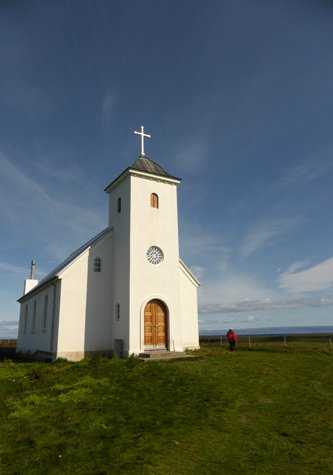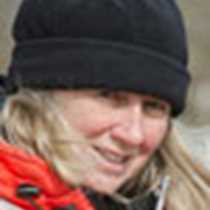Overnight, National Geographic Explorer headed northwards from Reykjavik to Breidafjordur, Iceland’s second largest bay. Thousands of small islands and skerries pepper its waters. To these shores the Norse came in the 9th and 10th centuries attracted by the rich food sources that were found here, including fish, seals, whales, seabirds and their eggs.
What a splendid vista presented itself at 8:00 a.m. as we arrived just off its northern shore— the Latrabjarg Cliffs— an 8.6- mile-long wall of alternating layers of basalt rising in places to over 1,200 feet above the pounding waves of the Atlantic. These cliffs are a veritable avian high rise, with a variety of species occupying different sections of the sheer rock face where perfect nesting sites are afforded by the numerous rocky ledges. For centuries the packed seabird colonies were exploited during the breeding season for their harvest of eggs, collected by men lowered down the precipitous cliffs on ropes. Massive numbers of eggs were taken and were an important element in the local vernacular diet. Eggs were also sold and were a handy source of cash. Conditions this morning were excellent and the dramatic topography with its kaleidoscope of shifting light, colour and shadow, and countless seabirds flying through the air or rising in rafts on the water’s surface, immediately engaged.
Some distance out in the waters of Breidafjordur to the southeast lies Flatey, a small low-lying slab of ancient basalt. Looks can be very deceptive and this carries true for this modest, isolated island. This island was once a hub of religious and commercial activity. Founded by the Norse in the 10th century as a settlement, it became an important trading post that handled a variety of materials including iron, timber and wool. By the latter part of the 12th century it boasted an Augustinian monastery and became a renowned centre of religion, learning and literature. It was here that the famous Flateyjarbok, a late 14th century illuminated vellum manuscript, was transcribed. This contains versions of some of the Icelandic sagas and is regarded as the key text for Old Nordic studies. A facsimile copy of the volume is displayed in the island’s famous tiny library. Opened in 1864, this was Iceland’s first public library.
In small groups we explored the small hamlet of gaily coloured houses, its church with the mural depicting the history of the island community by the Catalan artist Baltasar Samper, the library, and also the bird cliffs where a variety of species were observed. Short Zodiac cruises around the adjoining islet on our way back to the ship allowed us to see kittiwakes, puffins, eider and purple sandpipers at close quarters. In addition, due to the low tide conditions, a number of large specimens of edible urchin, attached to the seaweed encrusted rock, were spotted. A great start to our voyage of discovery!









